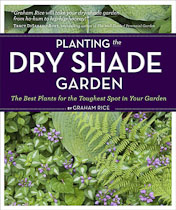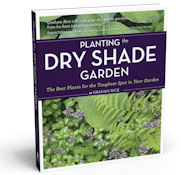Graham's Top Dry Shade Plants
Slideshow images by
judywhite & Graham Rice / GardenPhotos.com
Mouseover slideshow to see captions.
These ten plants have proved they will grow well in dry shade. Evergreens tend to predominate as they can utilize the available light through the full twelve months of the year. Of course, the more light and moisture levels can be increased by improving the conditions, the wider the range of plants from which to choose.
(Two of the most resilient plants for dry shade are, unfortunately, invasive in some areas. Ivy (Hedera) (z5) and Lesser Periwinkle (Vinca minor) (z4) are well behaved at the cold end of their range, but may be invasive in other areas so are excluded.)
Aucuba japonica (Japanese laurel)
Tough and resilient evergreen shrubs, the best forms feature variegated foliage, red fall berries - or both. The large oval, foliage may be glossy green or speckled, edged or splashed in yellow and although variegated forms may be a little slower in growth, they are still splendid performers in dry shade. z6-10.
Cyclamen (Cyclamen hederifolium)
Silvered ivy-shaped leaves arise from a steadily expanding tuber, fading away in summer then emerging in fall to last through the winter, even under weeks of snow. Pink or white flowers are held on short stems in late summer. z4-7.
Dryopteris (Male fern)
It is perhaps surprising that a fern should thrive in dry conditions but once established the lacy evergreen fronds of D. filix-mas are unexpectedly tolerant of drought. Shade, of course, they enjoy. The erect mid-green fronds are divided and divided again into opposite pairs of leaflets. 'Cristata' and 'Grandiceps Wills' are prettily crested at the tips if the leaflets. z3-6.
Epimedium (Barrenwort)
Evergreen barrenworts including E. x perralchium and E. perralderianum have bright yellow spring flowers held over tough but elegant holly-like foliage held on wiry stems. Amongst the most reliable for dry shade making good, weed smothering ground cover as well as dainty cut flowers. z5.
Euonymus 'Silver Queen'
An old favorite, effective and well-behaved as both ground cover and as a self-clinging climber on walls and tree trunks. The evergreen leaves are edged with cream in spring, fading to white and developing attractive pink winter tints. z5.
Iris foetidissima (Stinking iris)
Slender, pointed, rich green evergreen leaves arch from a tight crown and amongst them purplish flowers appear in early summer followed by unexpected bright, orange-red berries. Forms in other colors are occasionally available, try them all. z4-9.
Hydrangea anomala subsp. petiolaris (Climbing hydrangea)
Climbing hydrangea roots naturally at the base of trees, a very dry and shady place, then climbs the trunk using its aerial roots. In summer, the plant is covered with 10in white lacecap flowers. Also good on walls in poor light. z4-9.
Lamium maculatum (Deadnettle)
With its low spreading habit and its neat, nettle-like but non-stinging, foliage completely silvered or with a central silver splash, this is an easy and valuable plant which roots as it spreads but is rarely a nuisance. Two lipped red, pink or white spring flowers sit well just about the leaves. z4-8.
Lunaria annua (Honesty)
An easy biennial developing a bold winter rosette of dark green leaves then erupting in spring with airy spikes of our-petalled flowers in purple shades or white. These are followed by flat silver seedheads, the size of a silver dollar, ideal for drying. There are also forms with white-splashed foliage which add a whole new dimension. z5.
Ruscus aculeatus (Butcher's broom)
This tough-leaved evergreen has rich green leaves the texture of old dry leather with large scarlet berries on female plants. One of the most adaptable of all plants, Butcher's broom will steadily and relentlessly spread, but only slowly is are never invasive. The cut stems are useful and last an extraordinarily long time. Look for one of the self fertile forms such as 'Christmas Berry' or 'Wheeler's Variety'. z7.
Dry Shade Home / About Graham Rice / 10 Best Dry Shade Plants |
||||


